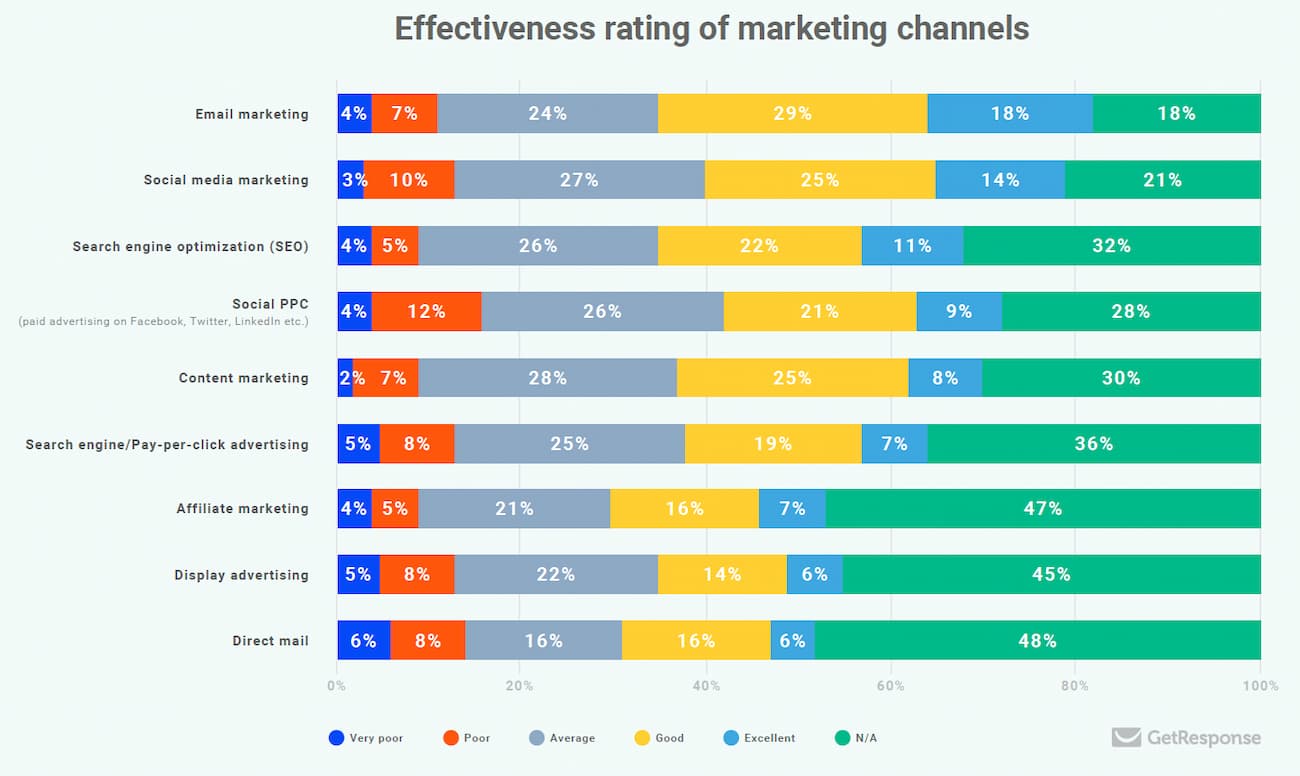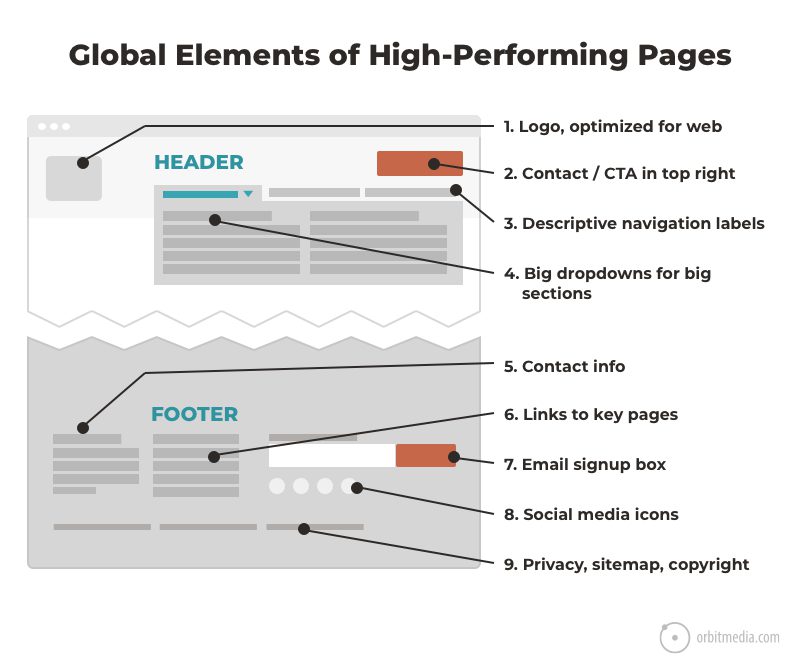Formats and the Funnel: How 17 content marketing formats align with lead generation
August 14, 2022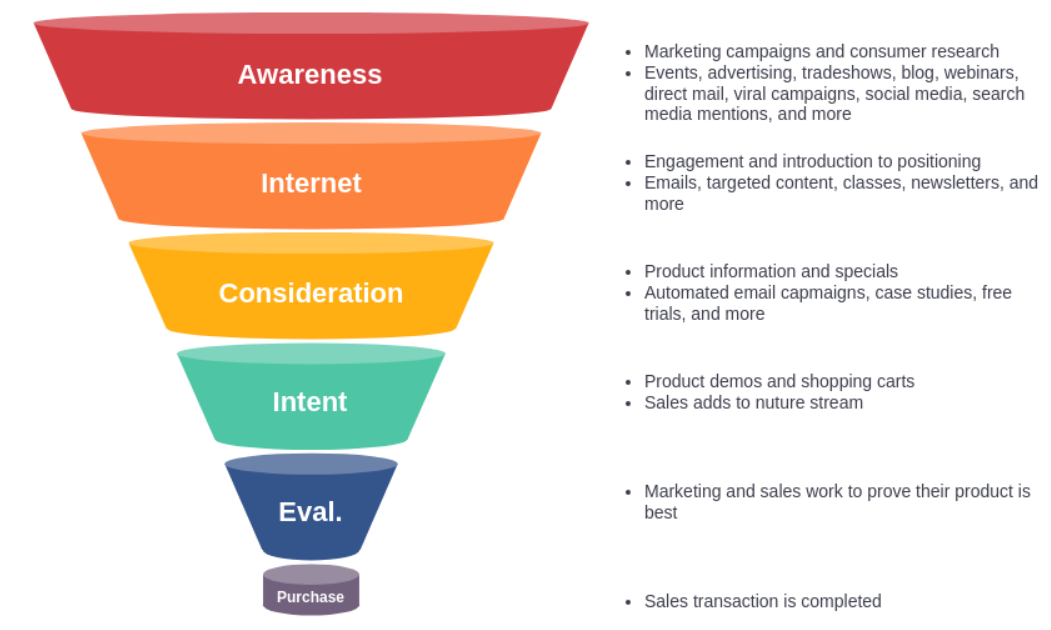
In many ways, web content helps the lead generation process.
Some content increases awareness and draws your audience closer to you. Other material increases confidence and generates leads directly. We all eventually come to understand how particular material affects particular funnel segments.
For both you and your visitor, the format of the material plays a significant role in the outcome. Case studies, list posts, and blog entries all have various formats and produce quite diverse marketing results.
Format follows function.
So the content marketer can make strategic choices about formats and create content specifically to strengthen different parts of the funnel.
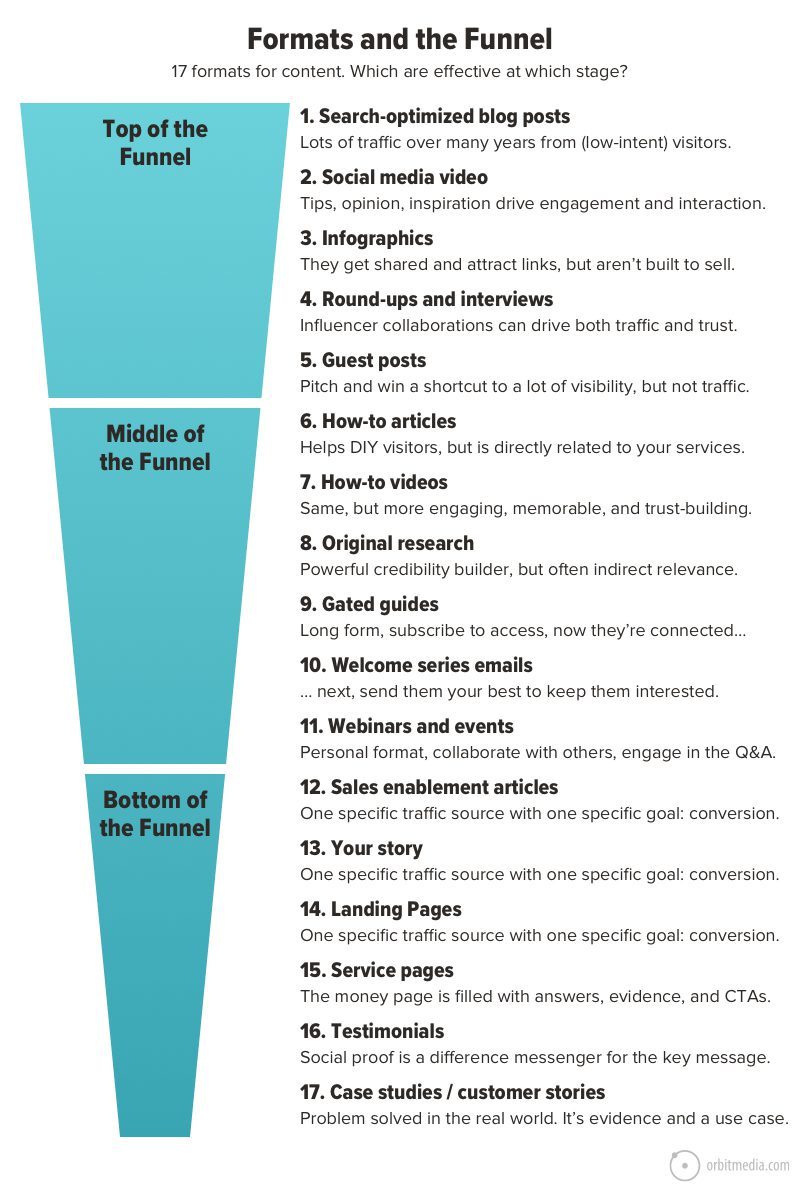
Quick note: The “lead generation funnel” is simply a way to think about the steps your audience takes on their way to becoming a lead. Of course, it’s not linear. Human behavior is chaotic and people are all over the place. But it’s useful for our purposes here. Hate the idea of funnels? Then you’ll like Drew Davis’ alternative model. It’s smart.
Let’s take a look at the specific content formats and how they align with funnel stages.
Top of the funnel: Content formats for traffic and/or awareness
Marketing goals: Brand awareness and visibility. Increase traffic. Establish general relevance.
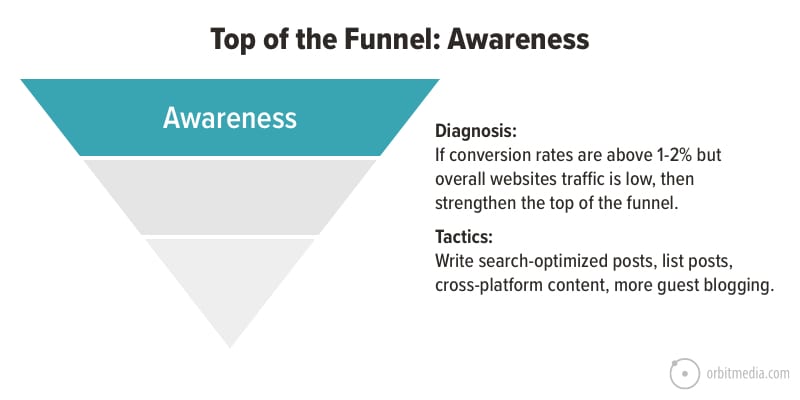
These top of funnel (TOFU) formats make you more visible, but similar to billboards and TV advertising, they don’t always reach the target audience. In content marketing, this inefficiency isn’t a huge concern because we aren’t paying for the reach. There is waste (high bounce rates), but it’s inexpensive waste.
Diagnosis: If your conversion rate from visitors into leads is 2% or more, but topline traffic is low, there is a weakness at the top. Any content marketing that involves these formats will help.
1. Search optimized blog articles
You may have a few of these already. They attract lots of traffic over long durations of time. There’s no denying that they drive awareness of the brand (these visitors are on your site after all) and “share of search” is actually 83% of a brands “share of voice.” Search visibility is brand visibility.
But let’s be honest, if the page is ranking for a purely information-intent keyphrase, these are some very low-intent visitors.
How do keyphrases indicate intent? See our keyword research guide.
2. Social media videos
The social platforms love video. Because video keeps visitors engaged, social media algorithms push social content to the top of everyone’s social streams. Videos that are clever in the moment or consistent over time can create a ton of visibility, especially practical tips and counter-narrative opinions.
But remember, visibility and website traffic aren’t always the same thing. Never expect high click through rates from social.
3. Infographics
They’re visual and practical, two factors that correlate with sharing and engagement. They’re more scannable than text-based content, so visitors may be more likely to come take a look. When combined with a little research and outreach, they can also drive press mentions and links.
4. Round ups and interviews
Clickthrough rates are high when the headline sounds like a list post (as with a roundup) or mentions an influencer (as with an interview). And any content created in collaboration with others may drive more shares if co-promoted with the collaborators. That’s called ego bait.
5. Guest posts
They have already gathered up the audience you’d like to reach. So rather than build that audience yourself from scratch, borrow access by writing for these publications. Beyond the immediate visibility, guest posts lead to follower growth (social) and links (SEO).
Take the time to build relationships with editors and that one-time post can turn into an ongoing collaboration (a regular column). That means lots of visibility, if not website traffic, over time.
Middle of the funnel: Content formats long game players
Marketing goals: Keep in touch over time. Demand generation. Connect with tire kickers. Email list growth.
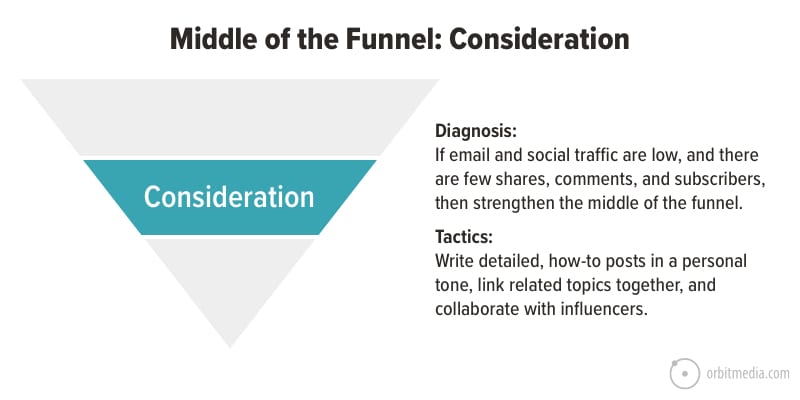
These middle of funnel (MOFU) formats are about the long game. They keep your audience engaged. These types of content are especially important when sales cycles are long and multiple decision makers are involved.
Diagnosis: If visitors aren’t returning, your email list isn’t growing, and you’re not seeing regular referrals for your services, there is weakness in the middle of the funnel. Try these tactics and topics…
6. How-to articles
When blog topics are directly related to the services you offer, they move into the middle of the funnel. These often attract DIY visitors who really just want to solve their own problems.
But they see your expertise. You’re now a valued resource. They may give up trying to do it themselves and come back. Eventually they may hire or refer you.
7. How-to videos
Similar to articles, but in a more engaging format. Video is inherently more personal, more memorable and better at building trust. Combine them with search optimized posts and your YouTube strategy is an automatic success.
8. Original research
Research is the one format that truly makes the website the primary source of new information. It’s also a powerful format for winning mentions, press and links.
It’s strong in the mid-funnel when it’s repeated annually and aggressively promoted. Eventually, your website becomes an important industry resource. That repeat traffic and trust is what the mid-funnel is all about.
9. Gated guides
The workhorse of every marketing automation program, gated content is designed to move the visitor down through the funnel. You give them some value, they give you their email address to get more value.
The “lead magnet” that triggers this transaction is usually a download of a long form guide.
Mini rant: An email address is not a lead, no matter what you’ve read. A lead is someone who has indicated they may need your services. A lead is an inquiry, ready to be qualified. An email address traded for a PDF file is not a lead.
10. Welcome series email
The next format in the process is email. Once they shared their address, you send a series of emails with links to more goodies and maybe even a straightforward sales message. It all happens automatically. It’s set up within the marketing automation system or the email service provider.
These are great for deepening engagement because this new subscriber was recently interested in something you published. Use the opportunity to promote your hardest working content.
11. Webinars and live events
Live formats are brilliant opportunities to repurpose high-performing articles, roll out research or collaborate with influencers.
- The personal format is both memorable and good for trust-building.
- They have deadlines, which means urgency which makes for great calls to action.
- They have audience interaction (Q&A) and dialog, which is a listening opportunity.
- They have a networking component and build community, which creates loyalty, relevance and exponential value for everyone.
Each of these is fantastic for the mid-funnel.
Really, they’re really at the bottom of the middle of the funnel. You may have read about these kinds of BOMOFU strategies, way better than the TOMOFU content some marketers use.
Bottom of the funnel: Action
Marketing goals: Build trust. Inspire visitors to act. Start a conversation. Turn “suspects” into prospects.
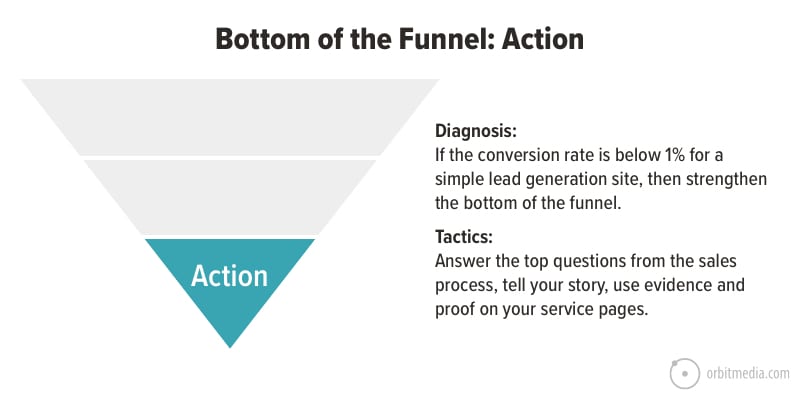
These bottom of funnel (BOFU) content formats directly support conversion rates and lead generation. They don’t attract new visitors; they simply maximize the percentage of your current visitors who become leads.
Diagnosis: If your site’s conversion rate is below 1%, there’s a problem in the bottom of your funnel. If your lead generation process isn’t complicated or your ecommerce checkout isn’t confusing, then the problem is probably your content.
12. Sales enablement articles
This may overlap with the types of articles already mentioned above. But not always. These articles are written for one specific purpose: sales.
When prospects all tend to ask the same questions, put your best answers into detailed articles with visuals, then show it on sales calls or share it in an email follow up afterward. That’s the basic idea behind “sales enablement” content. Support the sale.
This is perfect sales/marketing alignment, and it makes traffic and pageviews irrelevant. It is created specifically for the most important audience, your current prospects, and delivered to them personally.
These are also good fuel for your account based content marketing program.
13. Your story
Your visitor is making a tough decision. They’re unsure about your company as an option. They don’t yet feel a connection to your brand. That’s when they visit the About page.
Visitors on your About page are often in serious consideration mode. They know what you do, now they want to know who you are and what you believe. How it all started. What you are for and against. They’re looking for your story.
Your About page visitor may be near the decision stage, but they need a kicker to put them over the top. Share your history, your people and your values. When they feel that connection, they feel validation. They’re now far more likely to commit.
14. Landing pages
Technically, any entry point into a website is a landing page, but here we’re talking about campaign landing pages.
A true landing page has ONE specific traffic source (i.e. PPC, email, display)
and ONE specific goal (i.e. lead generation, email signups)
A landing page is an attempt to completely shortcut the funnel and get the visitor to take action on their first visit. Often, the standard header navigation is removed to keep the visitor from getting distracted.
15. Service pages
They say what you do, explain how you do it, show proof that you do it well and offer to help the visitor. The product or service page (aka, the sales page or “money page”) is the workhorse of the website. It combines a set of a dozen or more elements, but it really comes down to three things:
- Answers to top sales questions
- Evidence to support those answers
- Clear, specific calls to action
When sales pages are optimized for search (always for the commercial intent keyphrase) the visitor may enter the site here. Even so, they are still fundamentally bottom of funnel content.
16. Testimonials
Unique among all content formats, the testimonial changes the messenger, swapping in a member of the audience. The text becomes a testimony. The copy turns into evidence. And the tone is more legit than anything you could ever write yourself.
“Quotation marks are the most powerful punctuation on your keyboard.”
Most effective when it appears near the marketing claim it supports. Less effective in less visible places, such as on testimonial pages or hidden within sliders. Upgrade to the video testimonial for maximum impact.
17. Case studies / Customer stories
Beyond the testimonial is the case study. This format shows a real-world example. It’s a structured, detailed account of an actual problem, solved by the brand.
Case studies are stories with characters, conflict and a resolution. Just scanning it makes the value feel obvious, yet surprising. Mix in a few data points and give it a killer headline and you have your closer.
Formats are a key part of content strategy
The best content marketers are opportunistic and efficient. We look at formats as quick ways to spin one thing into something new. Influencer marketing and content pro, Stacy Jones, summarizes this concept perfectly.
We have written about this here on our blog. Our Periodic Table of Content is our original guide for turning one element into another.
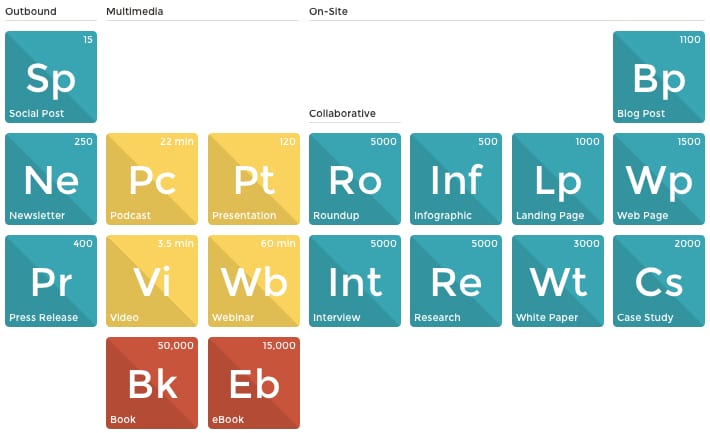
But the thinking about formats should be strategic, not just opportunistic. Look at your content. Look at your funnel. See any weaknesses? Do you have any sales enablement content yet? Are you using videos and webinars to keep your audience engaged? We hope this guide triggered some answers and ideas.
Check us on this one, please!
This article is based on our experience in many years of digital marketing. We did not read other posts on the topic, nor did we conduct new research.
If you’d like to share your experience with content formats and lead generation, we’d love to hear from you.
Article by Andy Crestodina of Orbit Media
